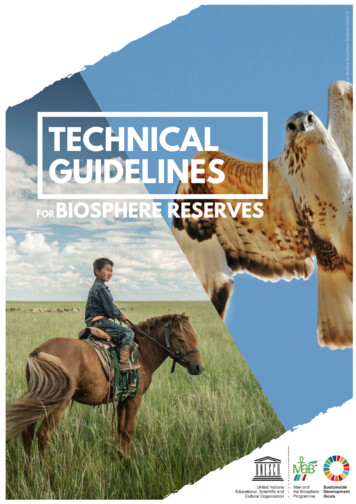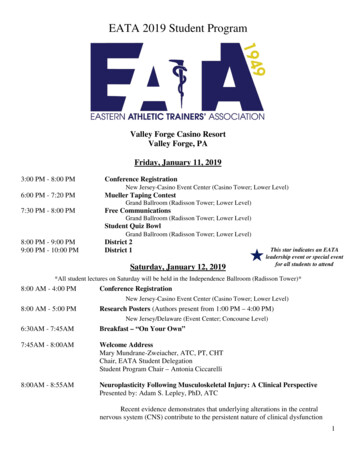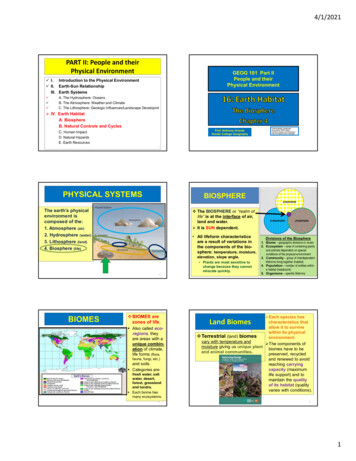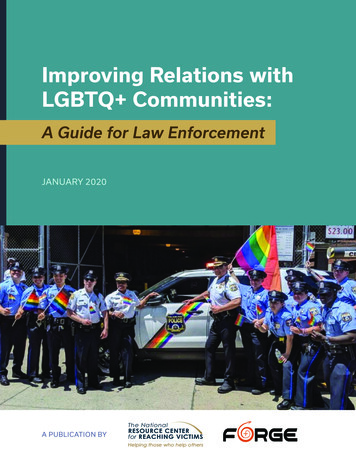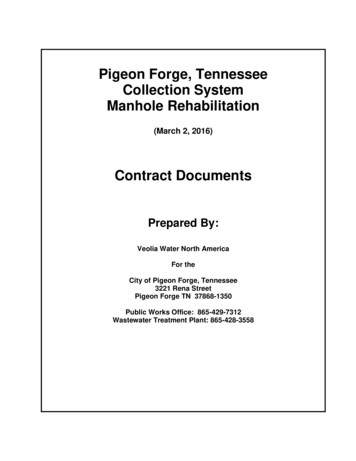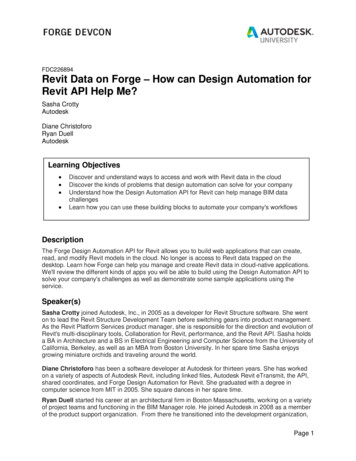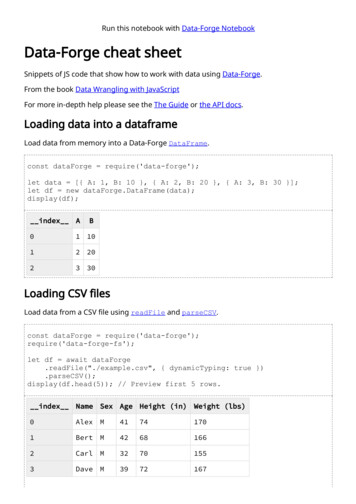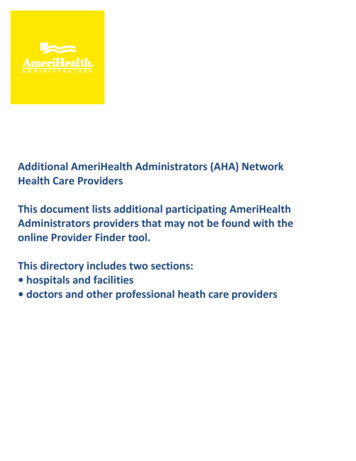
Transcription
Schoolyard BioBlitzAt a GlanceGrade Level: 4Learning Environment:Indoor classroom and anyschoolyard/trail/natural wildlifearea (NWA)Prep Time: 15 minutesLength of Lesson: 2 HoursDescription of LessonYou could refer to a Bioblitz as a scientific scavenger hunt thatgoes further than just finding objects. Through a Bioblitz,students can share and contribute to data monitoring andcollection programs here in Ontario. The class will makeobservations in the schoolyard or area of choice. This activityis a great introduction to citizen science. The Seek oriNaturalist App will help with this collection of data.Key Vocabulary: Biodiversity,biodiversity threats, invasivespecies, sustainability,stewardship, species at riskStaffing: 1 educatorMaterials:Smart device/computer/smartboard,field guidesConnect with the Long Point Biosphere RegionGroupings: Create groups of phere.comTeaching/Learning Strategies:This lesson plan and included media /materials are the property of LPBR unlessotherwise stated.observations /photography/graphingLong Point Biosphere Region: Lesson in a Backpack Program1
Lesson OutlineTIMEACTIVITYLOCATIONLesson 130 minutesDownload Seek/iNaturalistClassApp, review instructionsLesson 21.5 hoursSet up your groups, gooutside and make yourobservationsLesson 330 minutesReview the outcomereport of the class’sobservations/ tally timeExtensionsInvasive speciesMATERIALSSmart device/cameraFieldSmart device/camera, field guidesClassSmart board/tabletClassSmart board/tabletCurriculum Expectations Grade 4 - Science CurriculumUNDERSTANDING LIFE SYSTEMS: HABITATS AND COMMUNITIES1.0 Analyze the effects of human activities on habitats and communities.1.1 Analyze the positive and negative impacts of human interactions with natural habitats andcommunities (e.g., human dependence on natural materials), taking different perspectives intoaccount (e.g., the perspectives of a housing developer, a family in need of housing, anecologist), and evaluate ways of minimizing the negative impacts.1.2 Identify reasons for the depletion or extinction of a plant or animal species (e.g., hunting,disease, invasive species, changes in, or destruction of, its habitat), evaluate the impacts on therest of the natural community, and propose possible actions for preventing such depletions orextinctions from happening.3.0 Demonstrate an understanding of habitats and communities and the relationships among theplants and animals that live in them.3.1 Demonstrate an understanding of habitats as areas that provide plants and animals with thenecessities of life (e.g., food, water, air, space and light).Long Point Biosphere Region: Lesson in a Backpack Program2
BackgroundSustainability is the concept of meeting theneeds of the present without compromisingthe ability of future generations to meet theirneeds. Conserving and restoring naturalwildlife areas to the same as we have today,or better, helps create sustainability. Maybeto help in the effort your schoolyard could beconsidered in the big picture. In order topromote sustainability one must learn tosteward places to achieve sustainability.Stewardship involves understanding that weneed to use and care for the naturalenvironment in a responsible way and makethe effort to pass on to future generations noless than what we ourselves have access to.Values that are central to responsiblestewardship are: using non-renewableresources with care; reusing and recyclingwhat we can; switching to renewableresources wherever possible.Focus: citizen science, data collection,informal environmental assessments, speciesidentification and species monitoring.Cynthia BrinkSilver Spotted Skipper(Science focus: Biodiversity, ecology, classification, species at risk, invasive species.)Connect with the Seek App and share with the iNaturalist scientific community, uploadobservations to our NatureHood project. Observe statistics and how observations give us a better perspective of the decline or increaseyear to year of indicator species. Biodiversity is a measure of the number or variety of species present in an area or areas closeto species-specific habitats. Consider road ecology and safe roadside observations when reptiles and amphibians are onthe move. Species at risk reporting. Invasive species newly introduced to an area.(Focusing on only a couple of the above mentioned concepts can often be more productive.Choose your concepts before you embark on you adventure on the trails. So much is dependenton which habitat you choose to visit.)Long Point Biosphere Region: Lesson in a Backpack Program3
Teaching and LearningSeek by iNaturalist uses the power of imagerecognition technology to identify plants andanimals around you. It connects you and yourclass with a community of over 750,000scientists and naturalists that curate yourobservations helping you learn about nature onthe go.Sharing your observations through Seek toiNaturalist helps create quality data forscientists working to better understand andprotect biodiversity. Seek is a joint initiative bythe California Academy of Sciences and theNational Geographic Society.Referencing millions of wildlife observations oniNaturalist, Seek shows you lists of commonlyrecorded insects, birds, plants, amphibians, andmore in Norfolk County. Find out more aboutbiodiversity in our area by checking those listson the app by picking the geographical areaand species for which you may be curiousabout.Cynthia BrinkGetting Ready for a BioBlitzLesson 1You, as a teacher, can setup a classroom iNaturalist account which requires registration or you canhave the students download the Seek App on their smart devices which requires no registration.Decide to do both whatever works best for your class.Download the App!Before heading outside to your chosen area to use the App, there are a couple things you shouldtake the time to do with your class first.Some rules are very important for the class to understand before you start your schoolyard BioBlitz.Seek is the perfect blend of science and mobile technology, but misused in the classroom, results inpoor observations and observations that are obscure and hard to curate. In order to help you avoidsome common problems, here are some pointers to use Seek with your class prior to setting out intothe school yard. Add you're observations to Projects. Projects let you pool your observations with other people oniNaturalist. iNaturalist NatureHood Project – LPBR project is to identify plants and animals or act as a wayof collating data about the diversity of plants and animals in our area.Long Point Biosphere Region: Lesson in a Backpack Program4
Rules of EngagementImportant field rules:Take identifiable photos that are clear and up close. Make sure that you fill your frame with thespecimen and that the photo is in focus. For flowers and plants you can use your hand to hold theflower or plant that an insect is on. This can be challenging at times as some insects are quick. Besure that the plant is not poison ivy or anything that could irritate sensitive skin. A quick lesson onhow to use focus, enlarge, light level adjustment, and any other features the smart device mighthave would be helpful. Use some objects you have around the classroom to practice.Take more than one photo because some plants and insects cannot be identified to species from asingle photo. Have students take multiple photos from the top, bottom, side, front and back if theycan.Capturing different features of the organism helps with the identification process. If the students aremaking observations of plants, take pictures of flowers, leaves, stem and/or fruit. Be sure thatmultiple photos of the same organism are added to the same observation. Refrain from doingmultiple observations of the same subject.Try to focus on wild organisms. It's easy to get carried away with cultivated plants and animals thatcan be found in the school yard. The iNaturalist community focuses on wild organisms, and willrespond more to pictures of weeds and bugs. Help your students understand the differencebetween cultivated organisms and wild organisms. If your class is finding it difficult to find wildorganisms, this could be a great opportunity to discuss the environmental concern around notfinding wild organisms.Be sure that when photos are uploaded that they have the proper GPS information. Sometimes thisinformation is lost if the photos are not uploaded in the field. This information is an important part ofthe observation. You may need to help your students confirm this information before submitting theirobservations.Long Point Biosphere Region: Lesson in a Backpack Program5
Life Science InventoryLesson 2Once the class understands the rules of engagement make sure to give them a timeline of 1 hourto do as many observations as possible. Designate a specific area of the schoolyard that eachgroup must stay within so that there is no cross over between them. Ensure that observationsare only made once of each species encountered.During the one hour BioBlitz if students don’t have access to data, observations can beuploaded once they are back in a class setting. Take 30 minutes to load and verify data oncestudents have access to data or WIFI. Have students pay attention to details such asspecies and location.Long Point Biosphere Region: Lesson in a Backpack Program6
Tally TimeLesson 3Write “Tally” at the top of your smart-board/flipchart. Have students refer to their observations of thedifferent species they uploaded during the BioBlitz. Make a list of all the species observed and writethe observations on the smartboard/ flipchart. Once you have your list completed review all thedifferent species you have on your list. Ask students to contribute a few interesting facts about thespecies they have observed during the BioBlitz.Give students time to examine their observations and remove any that may not be within the rulesreferred to above. Then have students tally the total number to conclude how many observationswere successfully uploaded.Analyze BioBlitz observation dataReview the observations and create a graph that will track how many of each species of flora andfauna were observed. Using the same groups that made their observations together, have themorganize their observations using the chart below. These groups will then analyze the observationdata based on species. Once the species have been organized by each group add them all togetheron your smart-board/flipchart in a graph format of your choice. Add more species if they are not inthe list below. The list was created just as a starting point. InsectBirdAmphibianReptileTreePlantArachnidAs groups add their species on the class graph, explain to them that they should be prepared toshare information regarding defining characteristics, total number of species and number ofobservations, the five most common observations, and any unexpected observations, as well asintroduced species, and any endangered species.Related discussion topicsDoes it look like you have and abundance of species? Do you have a lack of species? Why doyou think you have either an abundance or a lack of species? What could you do to improve theschoolyard to improve your numbers of native species?Have a serious discussion about very simple changes, and consider doing the extensionsincluded below, to encourage positive stewardship.Long Point Biosphere Region: Lesson in a Backpack Program7
Extention 1:Invasive species are spreading quickly, and you can report their location using the EarlyDetection and Distribution Mapping System EDDMapS.You can submit invasive species sightings using either a smartphone or a computer.Sightings are uploaded to EDDMapS and emailed directly to reviewers to confirm. Themaps and information are freely available to everyone. Having good data on invasivespecies and their locations improves our ability to manage and respond to them.Extension 2:Start small by adding native wildflowers to your garden, yard or balcony. Join forces withfriends and neighbours to share seeds and plants. Next, encourage schools, businessesand institutions to add pollinator-friendly plants to their gardens and properties. Stitchthis network of pollinator patches together and you’ve created your own Butterflyway!The Long Point Biosphere Region would like to thank the Ontario Trillium Foundation formaking this project possibleLong Point Biosphere Region: Lesson in a Backpack Program8
You could refer to a Bioblitz as a scientific scavenger hunt that goes further than just finding objects. Through a Bioblitz, students can share and contribute to data monitoring and collection programs here in Ontario. The class will make observations in the schoolyard or area of choice. This activity is a great introduction to citizen science.
